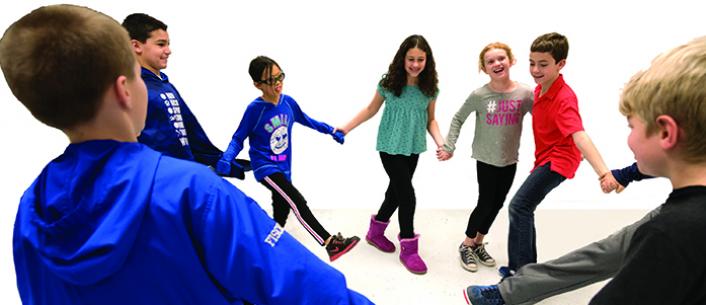How to Use the Music in Hebrew in Harmony
How to Use the Music in Hebrew in Harmony

Music is the core of Hebrew in Harmony. It’s what caught the eye of educators at Temple Chai Religious School in Phoenix.
“The music will reach students in their hearts,” says Ariela Ben-Dor, co-principal of the school. “It touches kids on a more emotional level than the cut and dry of teaching the mechanics of prayer.”
Hebrew in Harmony is a course for 4th-6th graders that harnesses the power of music to engage students with prayer. Each prayer module—15 available now, the final 7 coming in January—features several related songs as well as a traditional melody sung by today’s top musicians.
The course is designed specifically to be taught by educators, not musicians, though you can certainly involve your song leader, if you have one. Lessons contain directions for which songs to play and when to play them. The music serves many purposes within the lessons: students learn the words of the prayer by singing the songs, and they gain a deeper appreciation of music by analyzing the instrumentation, tempo, rhythm, and other musical elements.
To get started:
All the music for the series is in the digital app. Music for each prayer includes a traditional melody plus 2-3 musical interpretations of the prayer. If you're using an iPhone or iPad, the music and videos work offline, so you don't need a wifi connection. You should know that only prayer modules you've opened once are available offline, so make sure you to select the prayers you want to use with your students while you do have an Internet connection. If you have reliable wifi, you can stream the music directly off any wifi-enabled device. If that’s your preference, have your computer, phone or ipad and strong speakers ready. You can also hook up your device up to an Apple TV in the classroom and play the music to the whole classroom.
The Curriculum Core provides numerous techniques for using the music and tying it in with the student journal in each prayer module. Here are additional strategies:
1. Ensure you give the children a good music experience.
Whether you download or stream the music, play it using powerful, loud speakers. Let the music envelop the class. Listen together. You can also have students listen in pairs or small groups on individual devices. Then have students complete the music activities in the journals. (They are denoted int the journals with this music note icon.) This actively engages students with the music and students see it as integral to the program.
2. Play the music in the background.
Have music playing as students arrive, whether it’s from the prayer you plan to teach that day or a random selection of songs from other prayers. Repeated exposure to the music will help it become part of students’ deep memory.
3. Listen to the traditional recordings and practice the choreography.
In Avot V’imahot for example, a section called “Chanting and Moving” focuses on when and how to bow. By hearing the music while becoming physically engaged, students are more likely to remember the traditional movements. This need not be limited to choreography. For example, in L’chah Dodi, an activity called “Let’s Listen” has students singing and dancing to the music outside their usual learning space.
4.Use call-and-response when singing together.
Students find the word easier to remember when we break down the prayer into smaller, more manageable pieces. Play the cantors’ recordings of the traditional melodies and have children follow along in their journals (on occasion the complete prayer is reprinted in the Curriculum Core). Pause the music after each line for students to repeat the line after the cantor’s singing.
5. Use the lyric sheets for prayer exploration.
Help students gain a deeper understanding of prayer themes through the lyrics. Make copies of the lyrics included in the Curriculum Core. Have students work in pairs or small groups to answer questions you post on the board or a flip chart. Discuss together as a group.
6. Move creatively to the music.
Research shows that movement is one of the best ways to get all children to engage with and retain what they are learning. Have students stand in an open space with enough room to move. Invite them to start walking through the space in their regular way. Play the MP3 for the prayer you are teaching. Ask students to change the way they walk to reflect the instruments, tempo, volume, and spirit of the music—as they perceive it. After a minute, instruct students to make their motions bigger. If students are up for it, you can ask them to exaggerate their motions even more.
As the song winds down, have them go back to walking before coming to a stop at the end of the song. Discuss with the students how their movement changed and why. What was it about the music that made them move like that?
7.Have the cantor or song leader teach students songs to present to parents at a community Shabbat dinner, family service, retreat.
This type of engagement will integrate your learning space with real-life worship, it puts the learning into practice, and it gives parent a window into their children’s studies.
By using these techniques, and others of your own design, you’ll be able to do just what Temple Chai educators are most interested in doing in grades 5–6: “maximizing the music.”


